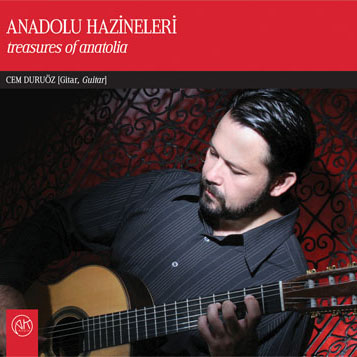| Track Listing |
Description |
[1] Haydar Haydar
listen...
(C) 2008 by Cem Duruöz |
Haydar Haydar is one of the signature pieces of Turkish folk singer and virtuoso bağlama player Ali Ekber Çiçek. It incorporates various compound meters such as (5/8, 7/8, 9/8) in a repetitive style reminiscent of western minimalism. The piece is from the Erzincan region and depicts bravery. |
[2] Yüksek Yüksek Tepelere
listen...
(C) 2008 by Cem Duruöz |
Yüksek Yüksek Tepelere is a folksong from the Edirne/Malkara region in Trace, which is the part of Turkey located on the Europen continent, near Greece and Bulgaria. It features a fast paced compound 9/8 rhythm (2+2+2+3), typical for the region. The song is about longing for the homeland. |
[3] Bozlak
listen...
(C) 2008 by Cem Duruöz |
Bozlak is one of the masterpieces of earlier turkish folk repertoire. The lyrics are attributed to Karacaoğlan, a 17th century poet/folk musician, and describes a warrier unfairly sentenced by the Sultan, to die. The introduction is written by Cem Duruöz based on another work attributed to Karacaoğlan. |
[4] Kolbaşı
listen...
(C) 2008 by Cem Duruöz |
Kolbaşı is an Ottoman Military rank and the work is one of the best known Janissari band pieces. The band would play such works not only during military ceremonies but also during the war itself usually intimidating the opposing army, perhaps the main motivation for European composers to write Turkish Marches during the most powerful centuries of the Ottoman Empire. European classical works like Rondo alla Turca by Mozart, Marche à la Turque by Marais and many other works by these and other composers such as Beethoven and Telemann use the rhythms typically found in this kind of Yanissari band music. This particular work is in a slow 9/8 compound rhytm, which was commonly used for bravery songs in Anatolia. Europen composers usually converted the accented beats to 4/4 to fit their own styles. |
[5] Sultaniyegâh Sirto
listen...
(C) 2008 by Cem Duruöz |
One of the master-works of the Turkish Classical Music, Sultaniyegâh Sirto is a well known piece with two main parts and four small sections in the second part. The sirto form is somewhat similar to the Western sonata in its length and its substential nature. The work starts with a slow 5/4 rhythm and later converts to a fast 4/4 dance music. |
[6] Cadenza Anatolia
listen...
(C) 2008 by Cem Duruöz |
Cadenza Anatolia is an original work of Cem Duruöz written as a Cadenza for Concerto Anatolia composed for him by David Hahn. The concerto features various Turkish rhythms and melodies and the cadenza utilizes the main 20/8 (3+3+2+2+3+2+2+3) motive of the second movement and dance motive from the fourth movement. |
[7] Nihavend Semai
listen...
(C) by Şerif Muhiddin Targan |
Nihavend Semai is a Turkish classical work written by the 20th century composer Şerif Muhiddin Targan, who was a virtuoso ud player. The dark sweet tone of the ud, which is unfretted, and its similarity to its sister instrument lute presents a wide range of possibilities for playing this music on the guitar. This is Cem Duruöz' arrangement. |
[8] Batum
listen...
(C) 2008 by Cem Duruöz |
Batum is a typical dance piece from the Black Sea region located at the northern part of Turkey. Its very fast 7/8 rhytm is well-suited for dancing; in fact the compound rhythm and the resulting the odd number of 8th notes per measure causes the dance to be extremely animated and exciting due to steps that have to be skipped. |
[9] Bahir
listen...
(C) 2008 by Cem Duruöz |
Bahir is the name given to each section of Mi'râciyye, a religious epic musical cycle written by Nayi Osman Dede, a 17th century composer, for the celebration night of the birth of Prophet Mohammad. The complete work is performed in Turkey every year during religious rituals marking the occasion. The slow and spiritual section in this recording is arranged and harmonized by Cem Duruöz. |
[10] Kadioğlu Zeybeği
listen...
(C) 2008 by Cem Duruöz |
Zeybek, a typical dance from western Turkey, is performed by all males dressed in an Ottoman soldier costume. It is always about bravery of these men and sometimes the dance includes props such as swords and knives. It is in 9/4 compound rhythm. There are similarities with some Greek rhythms emphasizing the interactions between the two cultures. |
[11] Kâtibim
listen...
(C) 2008 by Cem Duruöz |
Kâtibim, a folksong from the Istanbul region, is about a high level government employee and his flirtatious and sweet love. It might have originated in the Jewish minority communities of Istanbul, since it also has lyrics in Hewbrew. |
[12] Çile Bülbülüm
listen...
(C) by Saadettin Kaynak |
After the creation of the Turkish Republic in the 1920's, and abolition of the Court, Turkish Art Music developed as a continuation of the Turkish Classical Music; a new generation of composers kept the Ottoman tradition alive by writing new songs. In contrast to Ottoman period, the music was embraced by the wider public. Çile Bülbülüm, written by Saadettin Kaynak is perhaps the most popular example; it is always included in the live entertainment repertoire at traditional restaurants, and most Turkish customers love to sing along with it. |
[13] Sari Gelin
listen...
(C) 2008 by Cem Duruöz |
A bridge between Asia and Europe, Anatolia has been home to numerous cultures at different times. Sari Gelin is a perfect example for a treasure shared and similtaneously claimed by several cultures to be their own: Turkish, Armenian and Azeri (from Azerbaijan). Cem Duruöz' arrangement divides the work into three sections each with a different mood and tempo. The first section is an introduction, the second introduces the main melody in a slow 10/8 compound rhythm, and the last section uses the same melody but in 6/8, as played and heard in Azerbaijan. |
[14] Nihavend Longa
listen...
(C) 2008 by Cem Duruöz |
Another master-work of the Turkish Classical Music, Nihavend Longa was written by Kevser Hanim. It has four sections and one of them is repeated creating the rondo form. The makam (i.e. melodic mode) nihavend is equivalent to the Western minor scale. |





